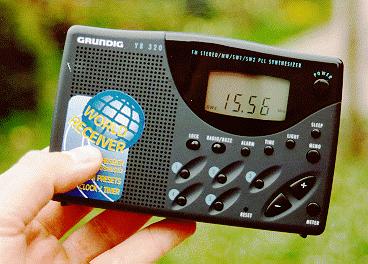
NB: ALSO SOLD AS TRAVELLER II DIGITAL
Year Introduced: Summer 1996
Power: Battery, AC adaptor optional
Size: 145 by 85 by 32 mm
Weight: 400 grams including batteries
Price: US$ 70, CAN$150. 119 Dutch Guilders
Coverage: MW, FM stereo, SW (2300 to 7400 kHz, and 9400 to 26100)
Value Rating star: 


This review was compiled independently. The Medium Wave Circle and Radio Netherlands has no financial connection with R.L. Drake, the manufacturer of this receiver.
The Yacht Boy 320 and Traveller II Digital are, excepting the badge, the same radio.
It is always interesting when you take off the back of a radio. Sometimes you find that two radios that look different on the outside are really the same when it comes to the electronics inside. This is the case with two radios on the Dutch market at the moment, both launched in mid-1996. The Philips AE-3650 which turns out to be electrically identical to this Grundig receiver. The clue is that the controls on the front are roughly in the same place, but the evidence is clear once you take the set apart. This is an example of what is called badge engineering. If you go to the factory in the Peoples Republic of China and are buying enough of these radios they are happy to put their electronics into your specially designed case and put your brand name on it. It happens all the time. Grundig tell us they have helped to design the unit and closely supervise the quality control.
At 119 Guilders in Holland or about 70 US dollars, this radio retails at around 15 dollars above the analogue radios designed for use on holiday. For that little bit more you get a radio with digital readout, PLL synthesized tuning and a 20 channel memory facilty. The radio measures 145 by 85 by 32 mm, it works off three penlight batteries and weighs in at 400 grams.
While you have the battery compartment lid off, it is a good idea to make some decisions before you put the batteries in. There are two little sliding switches inside. One allows you to select the steps on mediumwave, 10 kHz for the Americas and Caribbean, 9 kHz for travelling elsewhere. The other switch allows you to chose between continuous shortwave coverage or just the frequencies in the broadcast bands. Because some stations make use of way of band channels these days, there is no reason to restrict it unless you’re listening in a country where the authorities are extremely strict about what you’re allowed to listen to and might ask for a demo at customs.
The word continuous in the accompanying brochure is misleading though. The Grundig Yacht Boy 320 / Traveller II Digital covers FM in stereo from 87.5 to 108 MHz, mediumwave, which starts at 520 kHz and goes up to 1710 kHz (so the extended AM band in North America is covered), and shortwave coverage is from 2300 to 7400 kHz, and 9400 to 26100 kHz. There five buttons on the front of the radio. These are not for direct frequency entry, but they are used for recalling the stations in the memory. You can store five stations on mediumwave, five on FM, five below 7400 kHz and five above 9400. Note that there is no longwave coverage.
Frequency steps are 5 kHz on shortwave and no fine tuning in between. There are two buttons marked up and down. You navigate up or down the dial with these. There’s a button to jump to the next broadcast metreband, a lighted dial, plus a clock and alarm function. The speaker is closely matched to the cabinet, so the radio sounds much richer and fuller than many competing sets of the same physical size, also made in the Far East. Like most radios, the set will scan through the dial stopping at stronger, listenable signals.
Clearly some compromises have had to be made to keep the price down. The up-down method of tuning is not as convenient as the keypad system you find on radios costing about another 70 dollars. There’s no single sideband facility or any way to reduce the bandwidth when there’s a strong interfering signal near by. This radio is an example of the cheapest PLL synthesized set you can make. There are no frills. Performance is fair. The synthesizer generates quite a lot of internal noise, so we got better overall reception using an analogue radio costing 15 dollars less. But with this radio you can read out the frequency directly, so there’s no guesswork and you can store some of your favourite channels in the memory. Analogue/digital combinations like the new Sony ICF-SW40 cost about another 50 dollars and give better overall reception, but at a price of course.
We got just over 20 hours of listening from a fresh set of alkaline batteries, listening for periods of an hour a day. That’s not bad, but running the set off the mains is a lot cheaper. A mains power supply is not included as part of the package though.
In short, this radio is fair value for those who must have digital frequency readout. You can get better overall reception though using an analogue radio costing a little less, but you’ll have to do fine tuning. To get full advantage of digital tuning, slightly more expensive sets on the European market with keypad entry are also worth considering, providing your budget stretches that far. The choice, as always, remains with you.
This review first appeared on the Radio Netherlands website.